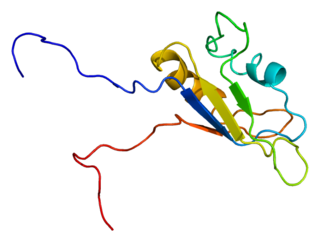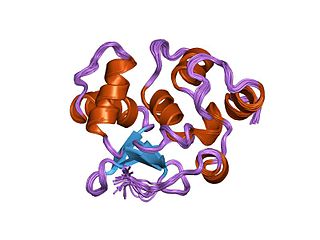Friend leukemia integration 1 transcription factor (FLI1), also known as transcription factor ERGB, is a protein that in humans is encoded by the FLI1 gene, which is a proto-oncogene. [5] [6] [7]
Friend leukemia integration 1 transcription factor (FLI1), also known as transcription factor ERGB, is a protein that in humans is encoded by the FLI1 gene, which is a proto-oncogene. [5] [6] [7]
Fli-1 is a member of the ETS transcription factor family that was first identified in erythroleukemias induced by Friend Murine Leukemia Virus (F-MuLV). Fli-1 is activated through retroviral insertional mutagenesis in 90% of F-MuLV-induced erythroleukemias. The constitutive activation of fli-1 in erythroblasts leads to a dramatic shift in the Epo/Epo-R signal transduction pathway, blocking erythroid differentiation, activating the Ras pathway, and resulting in massive Epo-independent proliferation of erythroblasts. These results suggest that Fli-1 overexpression in erythroblasts alters their responsiveness to Epo and triggers abnormal proliferation by switching the signaling event(s) associated with terminal differentiation to proliferation. [ citation needed ]
In addition to Friend erythroleukemia, proviral integration at the fli-1 locus also occurs in leukemias induced by the 10A1, Graffi, and Cas-Br-E viruses. Fli-1 aberrant expression is also associated with chromosomal abnormalities in humans. In pediatric Ewing’s sarcoma a chromosomal translocation generates a fusion of the 5’ transactivation domain of EWSR1 (also known as EWS) with the 3’ Ets domain of Fli-1. The resulting fusion oncoprotein, EWS/Fli-1, acts as an aberrant transcriptional activator. [8] with strong transforming capabilities. EWS/Fli-1 may steer clinically important genes via interaction with enhancer-like GGAA-microsatellites. [9] The importance of Fli-1 in the development of human leukemia, such as acute myelogenous leukemia (AML), has been demonstrated in studies of translocation involving the Tel transcription factor, which interacts with Fli-1 through protein-protein interactions. A recent study has demonstrated high levels of Fli-1 expression in several benign and malignant neoplasms using immunohistochemistry.[ citation needed ]
A possible association with Paris-Trousseau syndrome has been suggested. [10]

Ewing sarcoma is a type of pediatric cancer that forms in bone or soft tissue. Symptoms may include swelling and pain at the site of the tumor, fever, and a bone fracture. The most common areas where it begins are the legs, pelvis, and chest wall. In about 25% of cases, the cancer has already spread to other parts of the body at the time of diagnosis. Complications may include a pleural effusion or paraplegia.

ETV6 protein is a transcription factor that in humans is encoded by the ETV6 gene. The ETV6 protein regulates the development and growth of diverse cell types, particularly those of hematological tissues. However, its gene, ETV6 frequently suffers various mutations that lead to an array of potentially lethal cancers, i.e., ETV6 is a clinically significant proto-oncogene in that it can fuse with other genes to drive the development and/or progression of certain cancers. However, ETV6 is also an anti-oncogene or tumor suppressor gene in that mutations in it that encode for a truncated and therefore inactive protein are also associated with certain types of cancers.

T-cell acute lymphocytic leukemia protein 1 is a protein that in humans is encoded by the TAL1 gene.

MN1 is a gene found on human chromosome 22, with gene map locus 22q12.3-qter. Its official full name is meningioma 1 because it is disrupted by a balanced translocation (4;22) in a meningioma.

Protein C-ets-1 is a protein that in humans is encoded by the ETS1 gene. The protein encoded by this gene belongs to the ETS family of transcription factors.

Cyclic AMP-dependent transcription factor ATF-1 is a protein that in humans is encoded by the ATF1 gene.

Protein C-ETS2 is a protein that in humans is encoded by the ETS2 gene. The protein encoded by this gene belongs to the ETS family of transcription factors.

ETS translocation variant 4 (ETV4), also known as polyoma enhancer activator 3 (PEA3), is a member of the PEA3 subfamily of Ets transcription factors.

LIM domain only 2, also known as LMO2, RBTNL1, RBTN2, RHOM2, LIM Domain Only Protein 2, TTG2, and T-Cell Translocation Protein 2, is a protein which in humans is encoded by the LMO2 gene.

Transcription factor PU.1 is a protein that in humans is encoded by the SPI1 gene.

RNA-binding protein EWS is a protein that in humans is encoded by the EWSR1 gene on human chromosome 22, specifically 22q12.2. It is one of 3 proteins in the FET protein family.

ERG is an oncogene. ERG is a member of the ETS family of transcription factors. The ERG gene encodes for a protein, also called ERG, that functions as a transcriptional regulator. Genes in the ETS family regulate embryonic development, cell proliferation, differentiation, angiogenesis, inflammation, and apoptosis.

RNA-binding protein FUS/TLS, also known as heterogeneous nuclear ribonucleoprotein P2 is a protein that in humans is encoded by the FUS gene.

ETS translocation variant 1 is a protein that in humans is encoded by the ETV1 gene.

T-cell leukemia homeobox protein 1 is a protein that in humans is encoded by the TLX1 gene, which was initially named HOX11.

ETS domain-containing protein Elk-4 is a protein that in humans is encoded by the ELK4 gene.

Protein lyl-1 is a protein that in humans is encoded by the LYL1 gene.

In the field of molecular biology, the ETSfamily is one of the largest families of transcription factors and is unique to animals. There are 29 genes in humans, 28 in the mouse, 10 in Caenorhabditis elegans and 9 in Drosophila. The founding member of this family was identified as a gene transduced by the leukemia virus, E26. The members of the family have been implicated in the development of different tissues as well as cancer progression.
SAP1A is one of a family of proteins that contains a unique DNA binding domain termed the ETS domain.
EWS/FLI1 is an oncogenic protein that is pathognomonic for Ewing sarcoma. It is found in approximately 90% of all Ewing sarcoma tumors with the remaining 10% of fusions substituting one fusion partner with a closely related family member.
This article incorporates text from the United States National Library of Medicine, which is in the public domain.